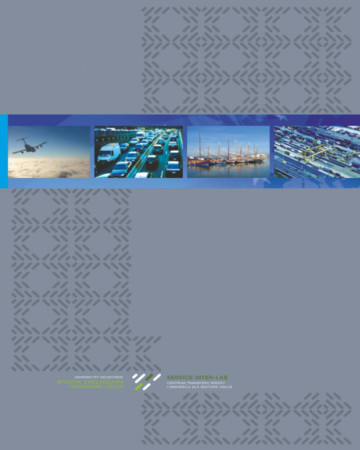
ISSN: 1644-275X
eISSN: 2353-3005
OAI
DOI: 10.18276/ptl.2018.43-06


Issue archive /
nr 3 (43) 2018
EMISSION FROM INLAND WATERWAY TRANSPORT IN THE CONTEXT OF ENERGY, CLIMATE AND TRANSPORT POLICY OF THE EUROPEAN UNION
| Authors: |
Emilia
Kuciaba
Wydział Zarządzania i Ekonomiki Usług, Uniwersytet Szczeciński |
| Keywords: | inland waterway transport transport policy energy and climate policy |
| Data publikacji całości: | 2018 |
| Page range: | 11 (61-71) |
| Klasyfikacja JEL: | Q54 P16 R49 |
Abstract
The low emission mobility is one of the major goals of the European transport policy. Energy
and climate policies accelerated the potential of transport to shift towards low emission
mobility. In addition, promoting multimodality will strength the shift towards lower emission
transport modes such as inland waterway transport and rail. Although inland waterway
transport is not the main source of air pollution in the European Union, the modal
shift may result in an increase of emissions from this mode of transport in the next years.
The goal of this paper is to trace the issue of emissions from inland waterway transport in
the context of European energy, climate and transport policy with particular attention to
measures to reduce emissions in inland waterway transport.
In order to trace these issues, the latest energy, climate and transport policy documents
were analyzed. There is also a comparison of the results of two research studies on emissions
from inland vessels in order to describe its energy efficiency and the ability to interfere
with the objectives set by the low emission policy.
Characteristics of the IWT are the longevity of the engines, less stringent emission limits
for inland shipping compare to the other land-based modes of transport and the relatively
small and specific market for inland vessels causes disadvantages of scale. These qualities
determine most measures for reduction of emission in IWT.
The IWT vessels emit relatively few greenhouse gases, but can have rather high values
for pollutant emissions, when compared to railways and trucks. Most measures for the reduction
of emissions in IWT at the same time also reduce fuel consumption, and therefore
have both ecological and economic benefits.
New strategy for low-emission mobility in inland waterway transport is electric power. Converting
inland ships to electric power is an interface between technology and sustainability.
Digitalization is necessary to improve the competitiveness of inland waterway transport.
Digitalization is also the tool to provide multimodal integration. This could incentivize
a modal shift towards inland waterway transport.
Download file
Article file
Bibliography
| 1. | 2030 climate and energy framework (2018). European Commission. Retrieved from: https://ec.europa.eu/clima/policies/ |
| 2. | strategies/2020_en (7.07.2018). |
| 3. | Clean Air campaign (2018). Retrieved from:http://www.cleanair-europe.org/en/projects/bund/clean-inland-shipping/ |
| 4. | (7.07.2018). |
| 5. | Communication from the Commission to the European Parliament, the Council, the European Economic and Social |
| 6. | Committee and the Committee of the Regions. A European Strategy for Low-Emission Mobility (2016) |
| 7. | COM/2016/0501 final. |
| 8. | Committee and the Committee of the Regions. Energy Roadmap 2050 (2011) COM/2011/885. Retrieved from |
| 9. | https://eur-lex.europa.eu/LexUriServ/LexUriServ.do?uri=COM:2011:0885:FIN:EN:PDF (10.7.2018). |
| 10. | Contribution to impact assessment of measures for reducing emissions of inland navigation (2013). Panteia. Retrieved |
| 11. | from: https://ec.europa.eu/transport/sites/transport/files/modes/inland/studies/doc/2013-06-03-contributionto- |
| 12. | impact-assessment-of-measures-for-reducing-emissions-of-inland-navigation.pdf (7.07.2018). |
| 13. | Dutch Company Introduces Autonomous Electric Barge in Europe, “Clean Technica” (2018). Retrived from: https:// |
| 14. | cleantechnica.com/2018/01/13/dutch-company-introduces-autonomous-electric-barge-europe/ (8.07.2018). |
| 15. | European Commission, climate negotiation. Retrieved from: https://ec.europa.eu/clima/policies/international/negotiations/ |
| 16. | paris_en (8.07.2018). |
| 17. | European Environment Agency (2017). Retrieved from: https://www.eea.europa.eu/data-and-maps/indicators/transport- |
| 18. | emissions-of-greenhouse-gases/transport-emissions-of-greenhouse-gases-10 (7.07.2018). |
| 19. | European Strategies, European Commission (2018). Retrieved from https://ec.europa.eu/transport/themes/strategies/ |
| 20. | 2011_white_paper_en (7.07.2018). |
| 21. | Eurostat (2018). Retrieved from: http://ec.europa.eu/eurostat/statistics-explained/index.php/Greenhouse_gas_emission_ |
| 22. | statistics. |
| 23. | Hoen, M., den Boer, E., Otten, M. (2016). STREAM Freight transport 2016. Retrieved from: https://www.cedelft.eu/ |
| 24. | publicatie/stream_freight_transport_2016/1855 (25.06.2018). |
| 25. | Keuken, M.P., Moerman, M., Jonkers, J., Hulskotte, J., Denier van der Gon, H.A.C., Hoek, G., Sokhi, R.S. (2014). Impact |
| 26. | of inland shipping emissions on elemental carbon concentrations near waterways in The Netherlands. Retrieved |
| 27. | from: https://www.researchgate.net/publication/263088683_Impact_of_inland_shipping_emissions_on_elemental_ |
| 28. | carbon_concentrations_near_waterways_in_The_Netherlands (7.07.2018). |
| 29. | Market Observation Inland Navigation in Europe Annual Report (2017). Retrieved from: https://www.inland-navigation- |
| 30. | market.org/en/rapports/2017/q2/9-emissions-in-inland-navigation/ (7.07.2018). |
| 31. | RIS (2018). Retrieved from: http://www.ris.eu/general/what_is_ris_/description (7.07.2018). |
| 32. | Siegemund, S., Trommler, M., Kolb, O., Zinnecker, V. (2017). “E-fuels” Study, The potential of electricity-based fuels |
| 33. | for low-emission transport in the EU. An expertise by LBST and DENA. Retrieved from: https://shop.dena.de/ |
| 34. | fileadmin/denashop/media/Downloads_Dateien/verkehr/9219_E-FUELS-STUDY_The_potential_of_electricity_ |
| 35. | based_fuels_for_low_emission_transport_in_the_EU.pdf (7.07.2018). |
| 36. | Transport emissions, European Commission (2018). Retrieved from: https://ec.europa.eu/clima/policies/transport_en |
| 37. | (25.06.2018). |
| 38. | White Paper. Roadmap to a Single European Transport Area – Towards a competitive and resource efficient transport |
| 39. | system COM(2011) 144 final. Retrieved from: http://eur-lex.europa.eu/LexUriServ/LexUriServ.do?uri=COM:2 |
| 40. | 011:0144:FIN:en:PDF (25.06.2018). |